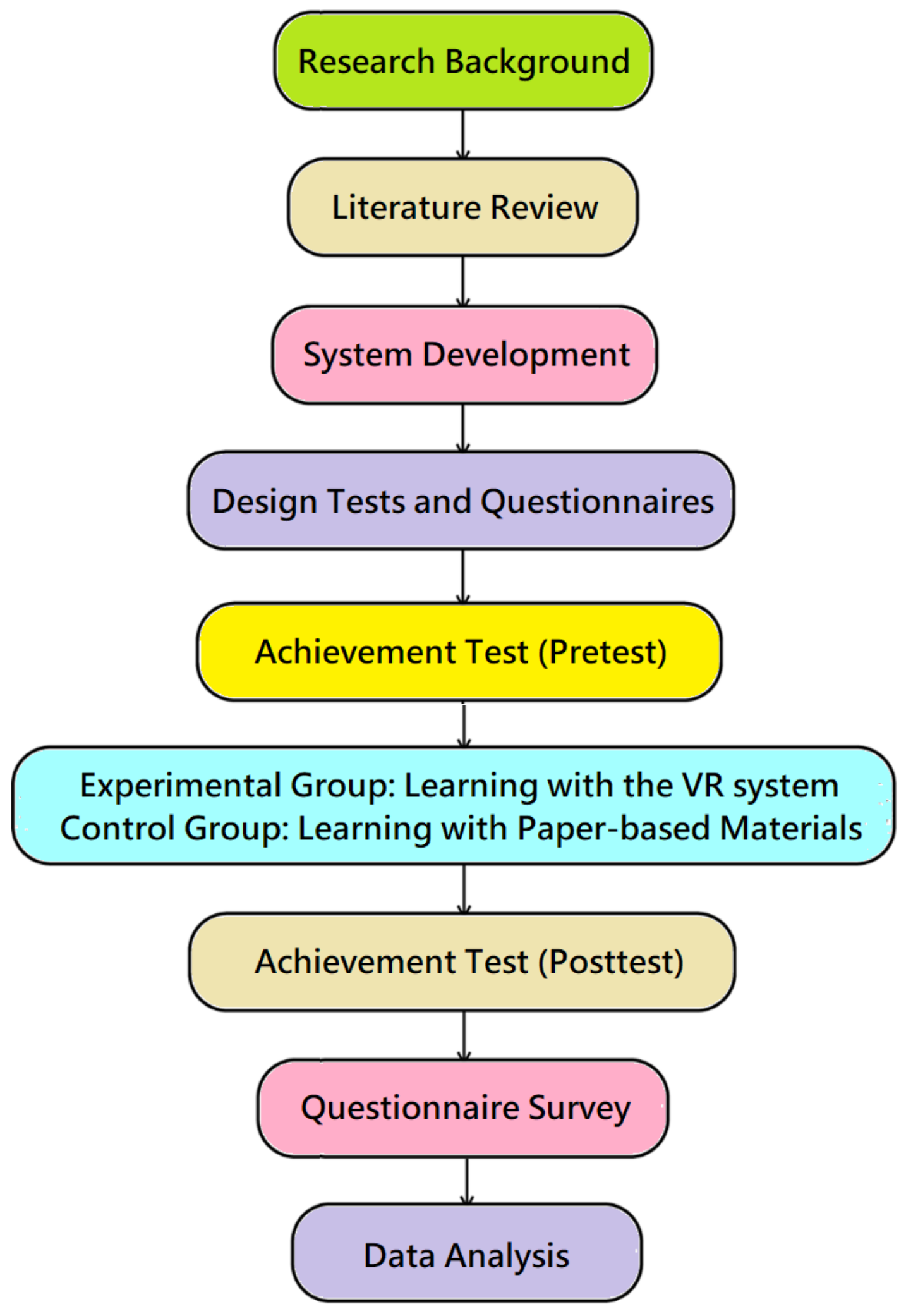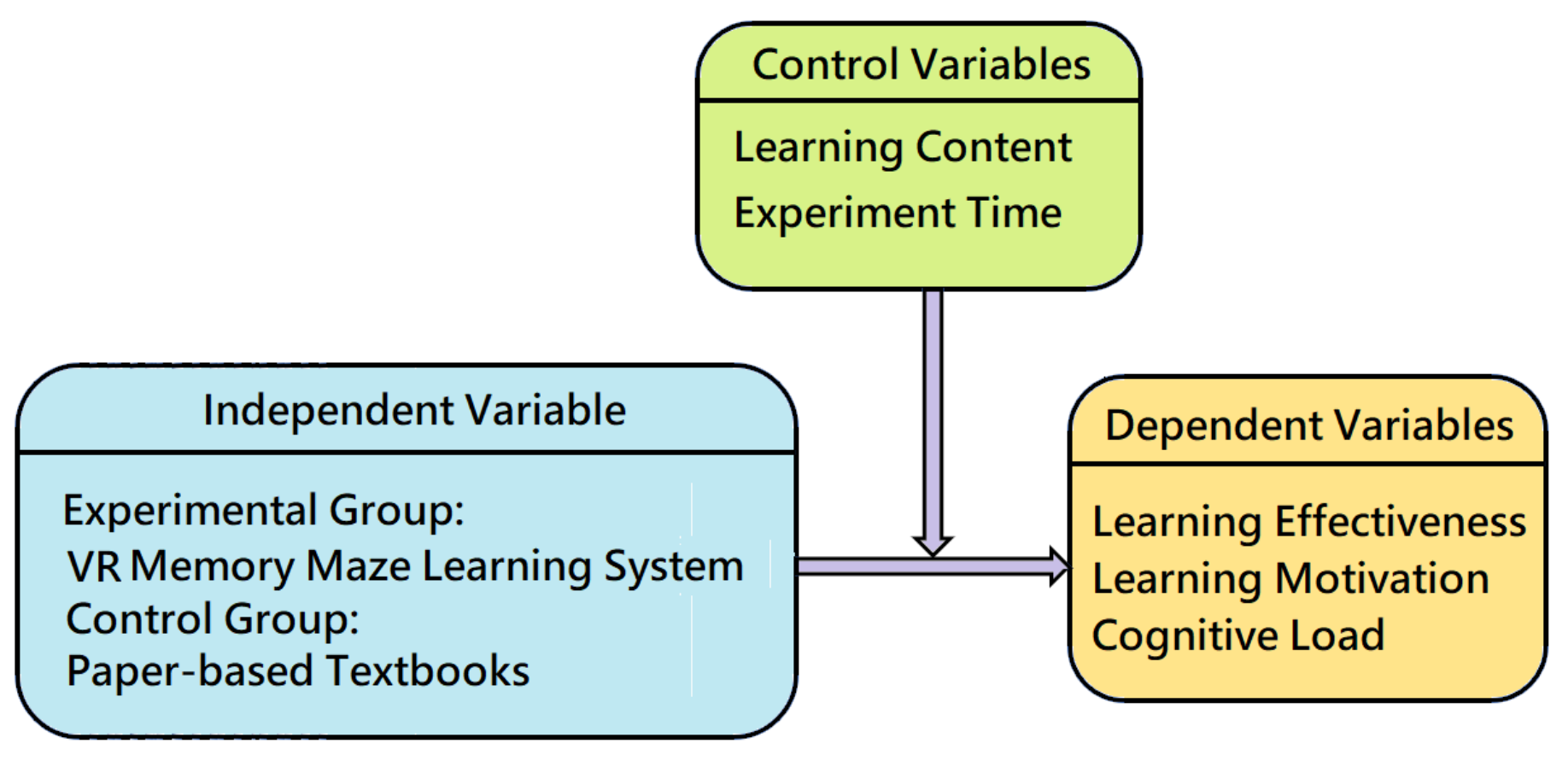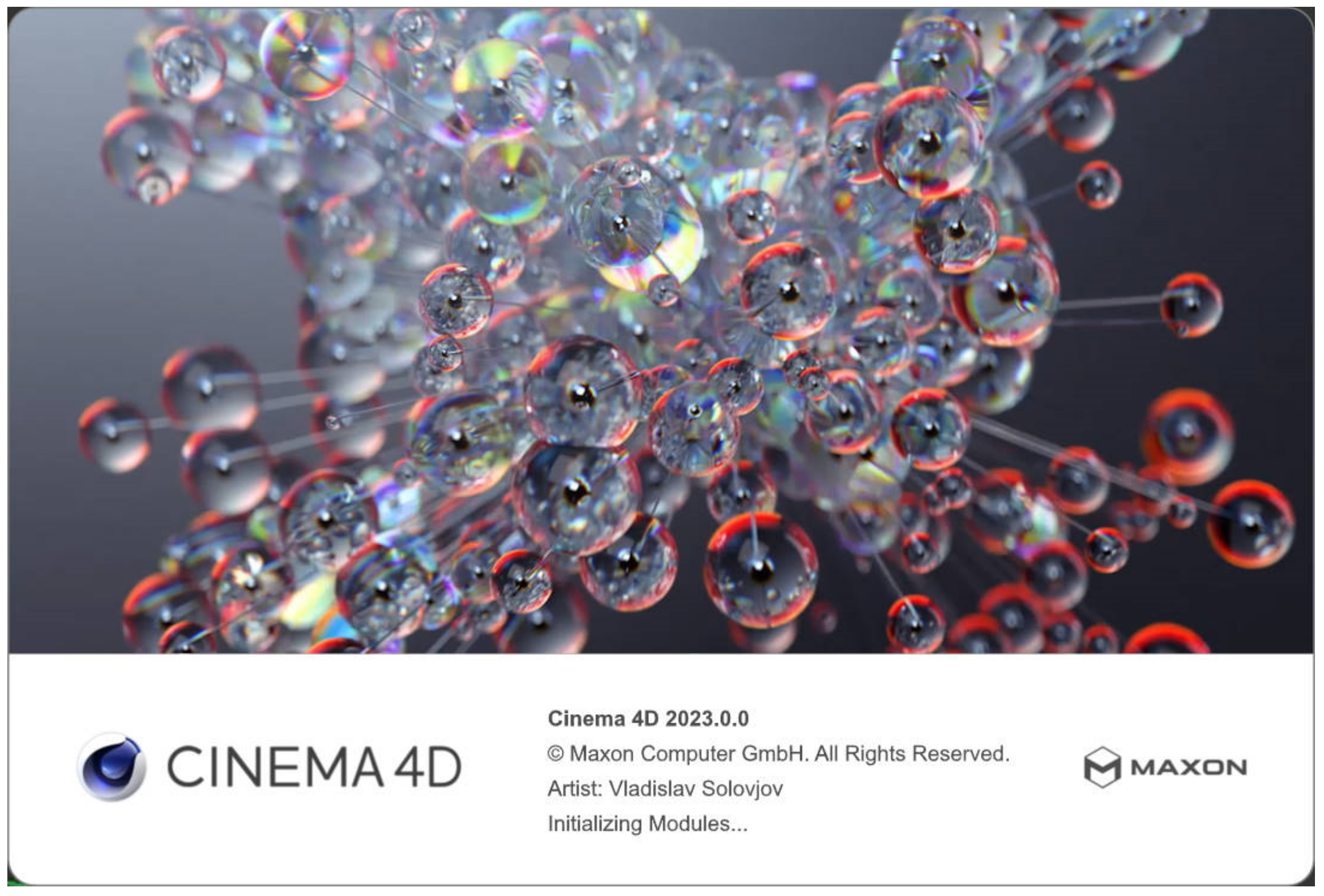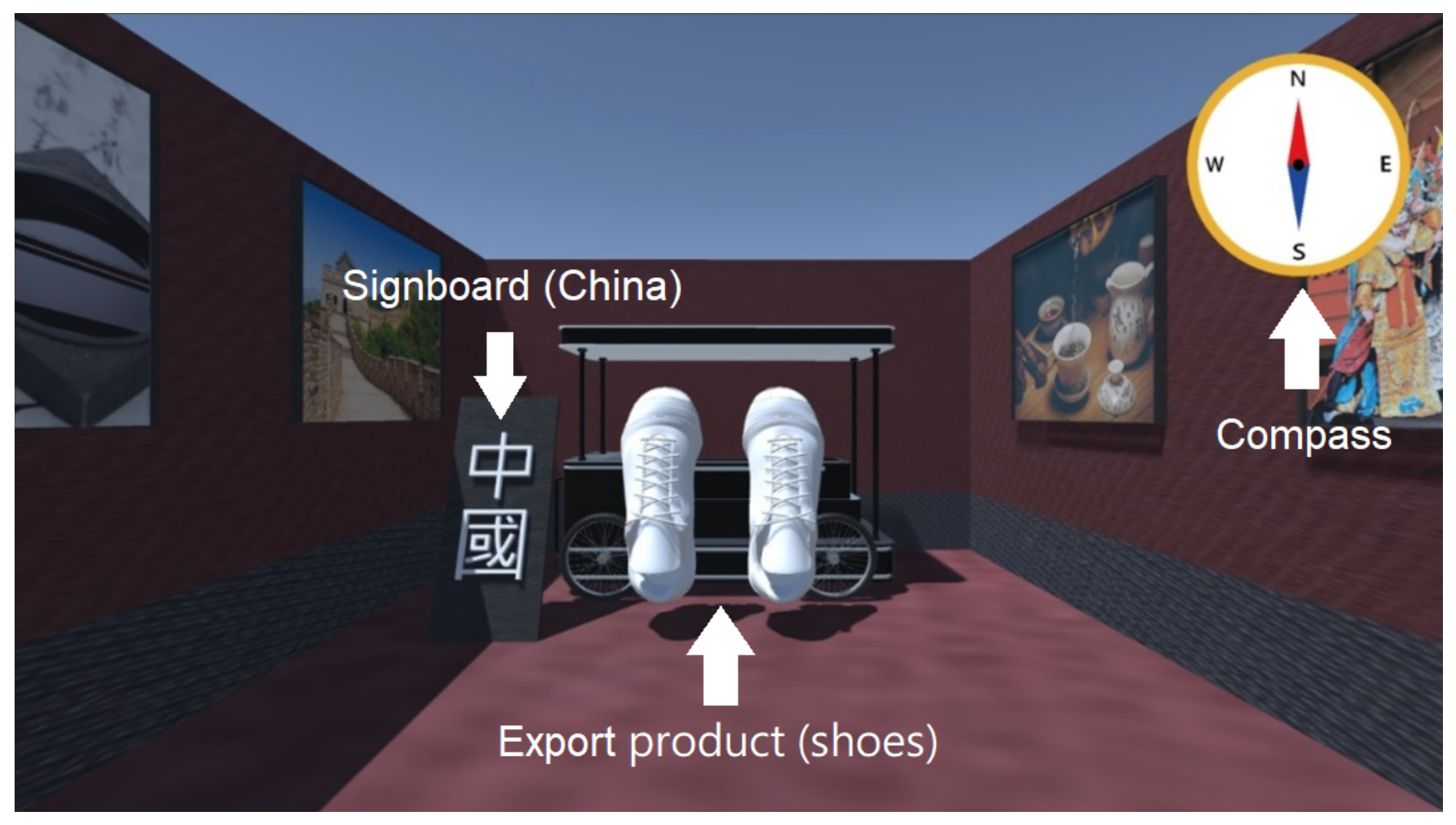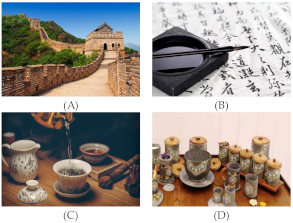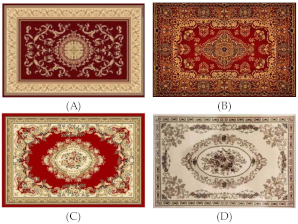1. Introduction
In recent years, the application of virtual reality (VR) in education has attracted the attention of many teachers and students. This study combined VR technology and concepts of spatial memory in wayfinding and memory palace to develop a VR memory maze learning system. The objective is to improve memory and efficiency in learning social science with a lot of historical and geographic context through the correlation between spatial information and organizational skills in the virtual environment.
1.1. Historical Context
The content information of the VR learning system is based on the expedition voyages of Zheng He in the early Ming Dynasty of imperial China, including seven consecutive large-scale ocean voyages from 1405 to 1433 to the West, 80 years before Columbus discovered America. Zheng He led a large fleet of more than 240 ships and 27,400 crew members on a long voyage, visiting over 30 countries in the Indian and Western Pacific oceans and the neighboring regions. The visited areas spanned East Asia, Southeast Asia, the Indian subcontinent, the Arabian Peninsula, and East Africa. It was considered the largest ocean sailing project in the world at the time.
Zheng He’s fleet once sailed to the East China Sea, the South China Sea, and the Gulf of Thailand, going around the Strait of Malacca and entering the Andaman Sea and the Bay of Bengal. Then, they bypassed the entire south of India to the Arabian Sea and the Persian Gulf, entered the Red Sea from the Gulf of Aden, and also sailed to Madagascar in East Africa. The seven voyages of Zheng He not only made a considerable contribution to the development of political and economic relations with Asian and African countries but also contributed to the development of cultural exchanges between China and foreign countries. The expeditions also stimulated the movement of people and animals across oceanic space. It was a significant event in Chinese history as well as in the history of the world, and the impact is vast, far-reaching, and unexpected.
1.2. Wayfinding
Wayfinding encompasses all of the ways in which people orient themselves in physical environments and navigate from place to place. Effective wayfinding helps people understand where they are and enables them to arrive where they want to go. In the process of wayfinding, people often structurally construct cognitive maps in their minds and use directional clues and positioning landmarks to assist them. When people remember the spatial information in the environment, they can use a top-down hierarchical structure to assist their memory, including the ordering of spatial features. In this way, they can remember the spatial information during the wayfinding process. This skill can also be applied to learning or used anytime and anywhere in real life.
Arthur and Passini [
1] pointed out that the concept of wayfinding first appeared in 1960 in Kevin Lync’s work “Urban Imagery." In this article, wayfinding describes a person’s understanding and insight into the city. They believed that wayfinding should be an ongoing activity to solve uncertain spatial problems. Golledge [
2] proposed that wayfinding is a decision-making process related to path and direction positioning from the starting point to the final destination, and it is an active behavior with goals to achieve. Gluck [
3] defined wayfinding as the positioning and operational process enabling a person to move correctly from one place to another in a large environment. Gibson [
4] proposed an alternative explanation of wayfinding. It was described as the process when a person is in a strange environment and keeps asking and answering questions before arriving at their destination.
Darken and Sibert [
5] divided wayfinding behavior into three types: naive search, primary search, and exploratory search, according to the familiarity of space and the existence of targets. Naive search is the brute-force method of searching, and it checks for all possible ways to find the destination. A primary search is a quick search of the structures likely to contain the targets. An exploratory search is a preliminary search prior to starting the review with goals. If there are targets during wayfinding but the pathfinder is not familiar with the space for searching, the naive search usually forms a blanket search. A primary search will have a certain degree of understanding about the search area, so it is not necessary to conduct an exhaustive search. An exploratory search is a type of wayfinding in which the pathfinder is unfamiliar with the searching area or has no goals to achieve, so it belongs to the initial cognition process in an unfamiliar space.
Researchers have different views on the wayfinding process. Klippel [
6] proposed that the wayfinding process should include four subtasks: orientation, choosing the route, keeping on the right track, and discovering the destination. Chen and Stanney [
7] divided the wayfinding process into three stages: the information-generating process (or cognitive mapping), the decision-making process, and the decision execution process. Compared with the former, Darken and Peterson [
8] considered that the theoretical model proposed by Jul and Furnas in 1997 was relatively complete [
9]. Their model states that a destination is established when people are performing a search, and the goals may affect the selected wayfinding strategy as well as the acceptance and evaluation of perception. When receiving and evaluating perception, the pathfinder will collect spatial knowledge and gradually establish a cognitive map of the environment, which may also influence the final action taken according to the decision. The standard strategy of the models mentioned above is consistently utilizing a set of standard principles to help pathfinders orient themselves while navigating in an area to reach their destination.
1.3. Memory Palace
A memory place is an imaginary place used as a mnemonic device to recall things or objects by their positions. It is a memory enhancement strategy that uses visualization of familiar environments to enhance the recall of information. The process of wayfinding mainly relies on one’s acquisition of spatial knowledge. Darken and Peterson [
8] pointed out that Tolman [
10] was the first to propose cognitive maps to explain spatial knowledge in the brain, and there are two ways to obtain spatial knowledge: (1) the primary way is to acquire it directly from the environment; (2) the secondary way is to obtain it from other resources, and the most common resource is the map. Lynch [
11] proposed a theory about how to obtain spatial knowledge directly from the environment. He divided the spatial knowledge of an environment into five types, including (1) landmarks: optional destinations; (2) routes (or paths): for connecting landmarks; (3) nodes: path intersections; (4) districts: specific areas containing landmarks and paths; and (5) edges: signs indicating traffic interruptions. Spatial knowledge is helpful in finding the destination.
However, the theory of cognitive maps commonly used in wayfinding research is the Landmark, Route, and Survey (LRS) model proposed by Siegel and White [
12] as well as Thorndyke and Goldin [
13]. This model divides spatial knowledge into landmark, path, and overview knowledge. The pathfinders obtain landmark knowledge from the outside world first, and the landmark knowledge is static and independent at this time. They can perform wayfinding through the paths connecting these landmarks and obtain path knowledge as if drawing a route map in their minds. Finally, pathfinders develop overview knowledge when the route map is refined, and they can find the way to the destination even without passing through a path because they can estimate the distance and relative direction between two points. However, many maps today directly provide users with routes to their destinations.
The memory palace is a powerful memory and learning tool with a wide range of applications. Whether in academic areas, daily life, or other fields, this tool can help us improve memory and learning efficiency by correlating the spatial information of environments and organizational skills. According to historical records, there have been examples of using memory palaces to aid recall through spatial mapping and environmental attributes since ancient times. Camillo’s Memory Palace (1511) maps words or phrases to a model of the environment to help people recall phrases by visualizing their connections with the scenes [
14]. To be precise, memory palace is a spatial memory technique to improve memory retention by correlating spatial information to specific locations within an imagined physical space [
15,
16].
The study by Gelsomini et al. [
17] applied memory palaces to address the needs of second language learners. The research results show that using the concepts of memory palaces can help them learn a second language. Qureshi et al. [
18] used memory palaces to design interactive courses, allowing students to learn about insulin and diabetes. The results show that students learning through interactive courses with memory palaces performed better than those who learned through traditional lectures and independent study courses. The study by Ruchkin et al. [
19] used memory palaces to train children with Attention Deficit Hyperactivity Disorder (ADHD). Their research results showed that children who received training in memory palaces performed better on memory tests and were able to reduce the symptoms of ADHD effectively.
1.4. Virtual Reality
Virtual reality is a technology and research field that covers multiple disciplines, such as computer science, human-computer interaction, and perceptual psychology. McCloy and Stone [
20] described virtual reality as an immersive technology allowing people to use their senses and skills to interact with 3D computer data effectively in real-time. Riva [
21] defined virtual reality as a computer-generated virtual world that allows users to interact effectively in real-time through sensory stimulation. Kilmon [
22] defined virtual reality as a computer-generated 3D simulation environment where users can view, operate, and interact with the virtual objects inside the virtual world.
Lopreiato et al. [
23] defined virtual reality as a computer-generated 3D environment that can provide users with immersive effects. Kardong-Edgren et al. [
24] reviewed various definitions of virtual reality and suggested using the concepts of immersion and presence to define virtual reality. Combining the above concepts, we can define virtual reality as a computer-generated 3D space that allows users to immerse themselves inside by providing multiple sensory stimuli and conducting real-time interaction in the virtual world. According to the research of Lombard and Ditton [
25], the characteristics of virtual reality include immersion, interaction, and imagination, also called the 3I’s.
Virtual reality creates a realistic and believable virtual environment through technologies such as the head-mounted display (HMD), stereo sound, and tactile feedback, making people forget about the existence of the real world and immerse themselves in the virtual scene [
26]. The improvement of immersion can increase emotional connection and participation and lay the foundation for a richer and more realistic experience.
Virtual reality provides a wealth of interactive devices and methods, such as the hand controller, body posture tracking, and voice recognition [
27]. Users can interact with the objects in virtual scenes in real-time. According to Slater’s research [
28], enhancing interactivity can also make the virtual experience more immersive.
Virtual reality can stimulate human imagination and create rich and diverse virtual scenes and plots. Users can experience situations different from the real world to transcend the limitations of reality. The stimulation of imagination allows them to explore the unknown, experience different perspectives and feelings, and broaden the scope of thinking and creativity. According to the research by Riva [
29], the imagination of virtual reality is crucial to a sense of participation and engagement.
In recent years, the applications of virtual reality in different fields of education have gradually attracted people’s attention. Many studies have explored how virtual reality affects the learning process and achievement, as well as its potential applications in various subjects. Freina and Ott [
30] explored the impacts of virtual reality on student engagement and learning outcomes. Research results show that virtual reality can provide an immersive learning environment, which enables learners to become more engaged in learning activities. The immersive and interactive nature of virtual reality allows learners to practice what they have learned at their own pace.
Hwang and Hu [
31] used virtual reality to design teaching tools, observed students’ peer learning behavior, and analyzed the impact of virtual reality on solving geometric problems. The results show that using a collaborative VR system is more effective for students to learn geometric concepts than traditional paper-based learning. Izard et al. [
32] explored the use of virtual reality as a tool in medical training and education. Their findings show that virtual reality provides a virtual learning environment for medical students to practice in an immersive and interactive way. Through virtual reality, students can perform various exercises such as surgical simulation, case analysis, and clinical diagnosis in a safe and controlled environment to provide them with more practical opportunities as well as increase their self-confidence and professional skills.
Çaliskan [
33] explored the use of virtual field trips as an alternative to actual field trips, and the research results show that the former can simulate a field trip widely and support students with financial or physical disabilities. Based on the above literature review, the applications of virtual reality in education have huge potential. It can improve student engagement and learning outcomes, enrich the learning experience, and transform traditional teaching methods into more interactive and immersive learning activities. Therefore, virtual reality has a broader range of applications and can provide a more concrete and intuitive learning environment in various subjects.
1.5. Applications of VR in Wayfinding and Memory Palaces
In recent years, virtual reality technology has been applied in the research fields of wayfinding and memory palaces. Because wayfinding is the process of finding a target location in an unknown environment, virtual reality can provide users with a safe and controllable environment where they can practice and become familiar with wayfinding skills. Sharma et al. explored the effects of landmarks on wayfinding in a virtual environment [
34]. Their research results show that the number of landmarks has a significant impact on the effectiveness of wayfinding, and it is suggested to design an effective virtual environment with more landmarks to provide better wayfinding guidance.
Lingwood et al. [
35] used virtual reality to measure the wayfinding ability of children. Their results suggest that virtual reality can provide a safe and realistic simulation environment for children to acquire wayfinding skills. Jiang et al. [
36] used virtual reality to study the impacts of hospital green space on wayfinding and spatial experience. The results of their study show that using the green space in a hospital as landmarks can enhance people’s emotional state, spatial experience, and aesthetic perception to improve their wayfinding experiences effectively.
Kober et al. [
37] used virtual reality to rehabilitate spatial disorientation after brain injury. Their research results show that wayfinding training with virtual reality can effectively enhance a patient’s spatial cognition, which is suitable for the rehabilitation of defects related to spatial disorientation. Davis and Ohman [
38] used virtual reality to improve wayfinding abilities for the old people with Alzheimer’s. The results of their study show that adding salient visual cues can enhance wayfinding in complex environments for the older adults with Alzheimer’s.
Wayfinding is a complex psychological and cognitive process with a number of stages. The pathfinder must position himself, choose a path, stay on the right track, and finally reach the destination. The memory palace is a mnemonic device to store information in one’s mind, and it is a helpful technique for quick memorization. Considering the flexibilities and advantages of virtual reality, researchers began to apply it to wayfinding and memory palaces to improve memory retention.
In the study of Krokos et al. [
14], the VR and PC environments were used to simulate memory palaces in an experiment for comparison. Their research results show that a VR memory palace can enable users to connect with spatial information and improve their recall rate more effectively compared to the PC environment. In the study by Reggente et al. [
39], virtual environments were used as memory palaces to memorize 3D objects, and the research results show that virtual reality is practical in binding objects to spatial contexts for the enhancement of subsequent memory.
Huttner and Robra-Bissantz [
40] used virtual reality to simulate memory palaces for the user to memorize words. The results show that users with HMDs have a higher recall rate than those with laptops. The study by Moll and Sykes [
41] also used virtual reality to simulate a memory palace for learners to memorize words. Unlike the previous study, which used controllers for movement, theirs used KAT Loco sensors to simulate actual walking, and the results show that using the virtual memory palace can improve efficiency in memorizing words.
Lacking suitable learning methods, students may find it difficult to study geography and history because they have to appreciate the comprehensiveness, practicality, and correlation between spatial and temporal information. As a result, the driving force for learning is low without sufficient motivation and interest. Different from the studies mentioned above, this study is focused on learning the historical, geographic, and cultural knowledge of Zheng He’s expedition voyages in designing the VR memory maze learning system, and the research goals also cover the learning motivation and cognitive load when using the VR system for learning.
Through virtual reality technology, we can create a rich and realistic virtual environment to make the memory palace more vivid and interesting. According to the research background and motivation, this study combined virtual reality technology with the spatial concepts of wayfinding and memory palaces to develop a VR memory maze learning system based on the historical context of Zheng He’s expedition voyages. The objective is to improve memory and efficiency in learning social science by correlating spatial information and organizational skills in the virtual environment.
This study aims to explore the effectiveness of using the VR system for learning social science, specifically the historical events of Zheng He’s expedition voyages. The research goals of this study are listed below:
- (1)
Explore the impact of using the VR memory maze learning system for studying Zheng He’s expedition voyages on students’ learning effectiveness.
- (2)
Explore the impact of using the VR memory maze learning system for studying Zheng He’s expedition voyages on students’ learning motivation.
- (3)
Explore the impact of using the VR memory maze learning system for studying Zheng He’s expedition voyages on students’ cognitive load.
- (4)
Explore students’ technology acceptance of using the VR memory maze learning system for studying Zheng He’s expedition voyages.
3. Analysis Results
This study conducted a teaching experiment to analyze the differences in learning effectiveness, learning motivation, and cognitive load between the two groups to explore the performance of using the VR memory maze learning system for learning social science. The data collected in this study include the scores of the pretest and posttest as well as the questionnaire results of learning motivation, cognitive load, and the technology acceptance model. After performing statistical analysis, the results are described as follows:
3.1. Learning Effectiveness Analysis
According to the analysis results in
Table 2, the pretest mean of the experimental group is 48.22, and the standard deviation is 12.71; the posttest mean is 74.89, and the standard deviation is 11.70. The pretest mean of the control group is 49.56, and the standard deviation is 11.96; the posttest mean is 56.44, and the standard deviation is 13.30. It is obvious that the posttest mean of the experimental group is higher than that of the control group. The standard deviation of the posttest scores of the experimental group is smaller than that of the control group, indicating the distribution of posttest scores in the experimental group is more concentrated than that of the control group.
In order to examine if there is significant progress between the pretest and posttest scores of the experimental group and the control group, this study uses a paired samples
t-test to compare the means of two variables for a single group to see if a significant difference exists between the two tests. The results in
Table 3 show that the average difference between the pretest and the posttests for the experimental group is −26.666, with a standard deviation of 13.218; the average difference between the pretest and the posttest for the control group is −6.888, with a standard deviation of 15.008. It can be seen that the experimental group made more progress than the control group.
The t-value of the experimental group before and after the treatment is −11.050, and the p-value is less than 0.001, reaching the significant standard; the t-value of the control group before and after the treatment is −2.514, and the p-value is 0.018 < 0.05, also reaching the significant standard. The result indicates that using the VR system and paper-based teaching materials can both improve learning effectiveness. However, whether the difference between the two groups is significant has to be verified by the analysis of covariance (ANCOVA), a general linear model to evaluate if the means of a dependent variable differ across levels of one or more categorical independent variables.
Before conducting the ANCOVA, the homogeneity test of variance and the homogeneity test of regression slope have to be conducted to ensure that the variances of the experimental group and the control group are homogeneous for accepting the null hypothesis. The result of the homogeneity test shows that F = 1.503 and p = 0.225 > 0.05, indicating the variance homogeneity test of the two groups has not reached a significant difference; the test result of regression slope homogeneity shows that F = 1.497 and p = 0.226 > 0.05, also without a significant difference. It is confirmed that the experimental group and the control group are homogeneous, and the slopes of the two groups can be considered the same, so the ANCOVA can be conducted.
This study uses pretest scores as the covariate, posttest scores as the dependent variable, and learning methods as the independent variable. An ANCOVA is conducted to explore whether the learning effectiveness between the two groups has achieved a significant difference due to different learning methods. It can be seen from the analysis results in
Table 4 that the difference in learning effectiveness has achieved a significant level, F = 34.769,
p < 0.001, and the net correlation η2 = 0.379 ≥ 0.138, indicating a high correlation strength. According to the analysis results in
Table 2, the experimental group made more progress than the control group, so the VR system is more effective than the paper-based teaching materials in learning historical and geographic knowledge.
3.2. Learning Motivation Analysis
A descriptive statistic is used to analyze the mean, standard deviation, minimum, and maximum values of the questionnaire results for the two groups, and then the independent sample t-test is used to compare the difference in learning motivation between the two groups. When conducting statistical analysis, this study uses the effect size d to evaluate the significance of the difference. In general, the effect size d ≥ 0.2 means a small effect, d ≥ 0.5 means a medium effect, and d ≥ 0.8 means a large effect.
As shown by the descriptive statistical results in
Table 5, the mean of the experimental group is 34.07, the standard deviation is 4.65, the minimal value is 25, and the maximal value is 40. The mean of the control group is 22.20, the standard deviation is 7.68, the minimal value is 14, and the maximal value is 37. It can be seen that the average number of the experimental group is higher than that of the control group.
In order to determine if a significant difference exists in learning motivation between the two groups, this study uses an independent sample
t-test to analyze the impact on learning motivation by using different learning methods. The results in
Table 6 show that t = 7.244,
p < 0.001, and d = 0.715 > 0.5, indicating the difference between the two groups is a medium effect but close to a significant effect. From the above results, we can see that the control group and the experimental group have a significant difference in learning motivation due to using different learning methods. More precisely, using the VR memory maze learning system can achieve higher learning motivation than using traditional paper-based teaching materials.
The analysis results of the learning motivation questionnaire in
Table 7 show that the two groups achieved a significant difference, with
p < 0.001 in each question. It reveals that the control group and the experimental group have different levels of learning motivation due to using different learning methods. Specifically, the experimental group has a higher level of learning motivation than the control group. It is speculated that the 3I’s characteristics of virtual reality—immersion, interaction, and imagination—can improve the learning motivation of the learners in the experimental group.
3.3. Cognitive Load Analysis
There are six items in the questionnaire, including mental load, physical load, time load, performance, effort level, and frustration level. Descriptive statistics are used to analyze the mean and standard deviation of the questionnaire results for the two groups, and the independent sample
t-test is used to explore the difference in cognitive load between the two groups. From the analysis results in
Table 8, we can see that different learning methods have caused different cognitive loads. The significant differences in most indicators are less than 0.001. Only the significant difference in “mental load” is less than 0.05. It can be seen from the mean and standard deviation that the cognitive load of the control group is higher than that of the experimental group in terms of “mental load”, “physical load”, “time load”, “effort level”, and “frustration level”, but the score of the dimension “performance” is lower than that of the experimental group, indicating the VR system has a lower cognitive load and performs better than the paper-based teaching materials.
3.4. Technology Acceptance Model Analysis
In this study, the questionnaire for the technology acceptance model uses a five-point Likert scale to evaluate the technology acceptance of the experimental group after using the VR system. From the results in
Table 9, it can be seen that the average score of each question is greater than 4, indicating the degree of acceptance is between the range of “agree” and “strongly agree”. The overall average score of the questionnaire is 4.46, and the standard deviation is 0.49, showing that most learners have a positive attitude toward the acceptance of the VR memory maze learning system.
According to the ANCOVA results of achievement tests, the experimental group made more progress than the control group, so the VR system is more effective than the paper-based teaching materials in learning historical and geographic knowledge. The questionnaire results for learning motivation show that using the VR memory maze learning system can achieve higher learning motivation than traditional paper-based teaching materials. The questionnaire results also show that the cognitive load of the control group is higher than that of the experimental group in terms of “mental load”, “physical load”, “time load”, “effort level”, and “frustration level”, but the score of the dimension “performance” is lower than that of the experimental group. The results of the technology acceptance model analysis show that most learners have a positive attitude toward the acceptance of the VR memory maze learning system.
4. Discussion
In recent years, virtual reality has been widely applied in various fields, including science, engineering, entertainment, and education. This study allows us to understand the advantages of combining virtual reality with the spatial concepts of wayfinding and memory palaces. Using VR technology, we can create a rich and lifelike virtual environment to make memory palaces more diverse and effective. Experimental results also confirm the potential of wayfinding in virtual memory palaces for improving memory with more interest and less effort. A similar result shows that imagination in virtual reality is crucial to the user’s sense of participation and engagement [
29], so learners have a higher level of learning motivation when using the VR system.
The VR memory maze learning system developed in this study creates an interesting situation to stimulate learners’ motivation and enhance their learning effectiveness. It makes learners feel as if they were walking in a real maze, where they can learn the history, geography, culture, and export products of the countries visited by Zheng He during his expedition voyages to the West, and it is fun and helpful for strengthening memory. As a result, the VR memory maze learning system is more interesting and effective than the paper-based teaching materials for learning social science. The findings are similar to the research results in [
37], which show that wayfinding training with virtual reality can effectively enhance the patient’s spatial cognition.
A compass is designed in the virtual memory maze to indicate direction and help learners recognize the relative locations when passing by the booths of different countries. It can also provide them with spatial information and on-site assistance for constructing cognitive maps during the wayfinding process. As described in [
9], the pathfinders will collect spatial knowledge and gradually establish a cognitive map of the environment when receiving and evaluating the perception. This may also influence the final action taken according to their decisions. A more in-depth analysis and interpretation of the experimental results obtained in the previous section is described below:
According to the analysis results, the learning effectiveness of the experimental group is higher than that of the control group, and the difference has reached a significant level (
p < 0.001), indicating using the VR memory maze learning system is more effective than using the paper-based teaching materials for learning social science. The result is similar to the finding of Krokos et al.’s study [
14], that is, virtual memory palaces allow users to better connect with spatial information in the virtual environment and improve the recall rates of spatial information during the exploration process.
According to the analysis results, the learning motivation of the experimental group is higher than that of the control group, and the difference has reached a significant level (
p < 0.001), indicating virtual reality can improve learning motivation as compared with paper-based teaching materials. The finding is similar to that of Freina and Ott’s study [
30], which proposed that virtual reality provides learners with a hazard-free simulation environment, allowing unlimited attempts. Hence, it can improve learners’ engagement as well as learning motivation.
According to the analysis results, the cognitive load of the experimental group is lower than that of the control group, and the effect size d = 0.715 > 0.5, indicating using the VR system can reduce cognitive load. Among the dimensions of “mental load," “physical load”, “time load”, “performance”, “effort level”, and “frustration level”, only the first dimension has a lower significant level, and the remaining dimensions have a high significant level. It reveals that using the VR system to learn social science is more effective in reducing cognitive load than using paper-based teaching materials. A more in-depth discussion of the differences in the six dimensions is given below.
The dimension “mental load” has achieved a significant level, p = 0.01 < 0.05, a smaller degree of difference among the six dimensions. It is inferred that learners still required the process of thinking, memorizing, and searching, whether using the VR system or the paper-based teaching materials for learning. However, the VR system integrates wayfinding and memory palace concepts, making the learning process easier and more intuitive. Therefore, the experimental group’s cognitive load in terms of “mental load” is still lower than that of the control group.
For the dimension “physical load”, it is speculated that the learners in the control group must compare maps and the textural descriptions of different countries by turning between other pages, which is exhaustive and causes extra physical load. When using the VR memory maze learning system, learners only need to browse the information using the controller, and it is easier to switch between the cultural picture and its textual description, so the level of physical load is lower than that of the control group.
In the dimension “time load”, it is inferred that learners can immerse themselves in and interact with the VR system to enhance learning effectiveness. Although the study times of the two groups are the same, the level of time load for the experimental group is lower as compared with the control group because it can improve memory and learning efficiency through the correlation between spatial information in the virtual memory maze and cognitive maps as well as organized knowledge of each country.
In the dimension “performance”, it is speculated that the VR memory maze learning system combined virtual reality technology with the spatial concepts of wayfinding and memory palace so that learners can achieve better performance with less effort and further strengthen their memory by performing challenging tasks. Therefore, the performance of the experimental group is better than that of the control group. The results of the analysis of learning effectiveness also reveal that the learning achievement of the experimental group is significantly higher than that of the control group.
In the dimension “effort level”, learners using the VR system can naturally memorize the learning content while walking through the memory maze. However, learners in the control group have to memorize the learning content of the paper-based teaching materials in a limited amount of time, which requires great effort. Hence, the effort level of the experimental group is lower than that of the control group.
In the dimension “frustration level”, it is speculated that the VR system allows learners to immerse themselves in the virtual memory maze during the learning process. However, learners in the control group have to experience anxiety, irritability, stress, and uncertainty when trying to memorize the learning content. As a result, the frustration level of the control group is higher than that of the experimental group.
According to the analysis results of the technology acceptance model, learners were highly satisfied with all aspects of evaluation after the experiment. The mean score is 4.46 and the standard deviation is 0.49, indicating learners had a positive attitude toward the perceived usefulness, perceived ease of use, attitudes, and actual behaviors of the VR memory maze learning system.
In addition to the explorative learning activities, the VR memory maze learning system can also strengthen learners’ impressions through challenging tasks, and they can complete the missions to become familiar with the countries and their export products. It is similar to the finding obtained in [
18], which shows that students learning through interactive courses with memory palaces can perform better than those who learn through traditional lectures and independent study courses.
Although it is effective to apply virtual reality to wayfinding and memory palaces for learning social science, there are some research limitations in this study.
This study used Oculus Quest 2 and the VR memory maze learning system as the tools for learning social science. Currently, virtual teaching materials and related equipment have not been widely used as learning tools at school, so learners may not be familiar with the operation of such equipment, which in turn affects their operating process and learning results. In addition, students with 3D dizziness or VR motion sickness must be excluded to avoid affecting the experimental results.
For the convenience of conducting the experiment, this study recruited a number of graduate and undergraduate students from a university in Northern Taiwan as research subjects. Those participants with 3D dizziness or VR motion sickness were excluded to avoid affecting the experimental results due to physical discomfort when wearing the HMD, specifically the symptoms of dizziness and nausea resulting from motion sickness [
45]. Consequently, there were only 60 participants recruited in this study. Due to the limitations of a small sample size and specific samples, the results of this study may not be extrapolated to other age groups, areas, or participants‘ education levels.
This study used the learning content compiled by the researchers, and it is based on the geographic locations, historical events, cultures, and export products of the countries that Zheng He visited during his seven expedition voyages to the West in the early Ming Dynasty of imperial China. Therefore, the findings cannot be inferred from the learning content of social science, which is not within the scope of this event.
5. Conclusions and Suggestions
In recent years, the applications of virtual reality in education have attracted the attention of more and more people in different age groups. Applying virtual reality to memory palaces is an effective method for memory training because learners can naturally and intuitively memorize learning content during the exploration process. The VR memory maze learning system developed in this study contains learning content about the countries that Zheng He visited in his expedition voyages, allowing learners to navigate through, observe, and interact with the VR system to learn the history, geography, culture, and export products of these countries.
5.1. Conclusions
A teaching experiment has been conducted to explore the impacts of the VR system on the learning effectiveness, learning motivation, and cognitive load of learners, as well as their technology acceptance after using the VR system for learning social science, and the research goals of this study are satisfied as listed below:
- (1)
The experimental group made more progress than the control group, so the VR system is more effective than the paper-based teaching materials.
- (2)
The experimental group has a higher level of learning motivation than the control group due to the immersive and interactive features of virtual reality.
- (3)
The experimental group‘s cognitive load is lower than the control group because the former can naturally memorize the learning content using the VR system.
- (4)
Learners in the experimental group have positive attitudes toward the acceptance of using the VR system for learning social science.
5.2. Suggestions and Future Works
The analysis results obtained in this study after the teaching experiment can be used as a direction for improving the VR system in future studies. Since the virtual memory maze developed in this study has many corners, learners have to make several turns to find the way to the next booth, which may cause them to feel dizzy and uncomfortable after learning for a long time. In the future, the memory maze can be modified by using smoother paths when designing the VR system to avoid this problem.
This study is focused on the historical, geographic, and cultural knowledge of Zheng He’s expedition voyages to the West when designing the learning content of the VR memory maze learning system. Future research can be expanded to cover other learning content in social science for elementary and high schools to provide students of different ages with a more effective and interesting way of learning.
According to the findings of this study, it is considered that the VR memory maze learning system has a wide range of potential applications and can be further expanded to other academic disciplines. For example, the VR system can be used in learning Chinese to enhance students’ reading comprehension and writing skills. In that case, the virtual scenes can be designed to allow students to act as different characters in literary works to experience the plot of a story. Through interaction with the virtual world, learners are encouraged to have an in-depth understanding of the plot and characters of literary works, thereby improving their Chinese literacy.
Other applications include using virtual reality for learning art and music subjects, allowing learners to appreciate artwork and musical performances in an immersive way. The applications may contain the virtual scene of an art gallery (or a concert hall), where learners can appreciate the artworks (or music) created by famous artists (or musicians) from all over the world. When doing so, learners’ creativity can be stimulated, and their understanding of artworks (or music) can also be enriched.


